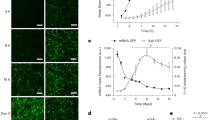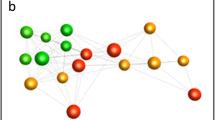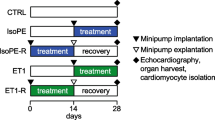Abstract
Rapid right ventricular pacing in anesthetized dogs results in marked protection against ischemia and reperfusion-induced ventricular arrhythmias, 24 h later. We have previous evidence that this protection associates with altered expression of genes, encoding proteins involved in the delayed cardioprotection. However, the sequence of transcriptional changes occurring between the pacing stimulus and the test ischemia has not yet been elucidated. Thus, we designed studies in which the expression of 29 genes was examined by real-time PCR at various time intervals, i.e., immediately (0 h), 6, 12, and 24 h after short periods (4 times 5 min) of rapid (240 beats min−1) right ventricular pacing in the canine. Sham-operated dogs (the pacing electrode was introduced but the dogs were not paced) served as controls. Compared with these dogs, pacing induced an early up-regulation of genes which encode, for example, HSP90, MnSOD, ERK1, PKCε, Bcl2, and sGC; all these somehow relate to the early phase of the protection. These genes remained either up-regulated or, after a transient lower expression (around 6 h), were up-regulated again, suggesting their involvement in the delayed protection. There were also some genes which down-regulated soon after the pacing stimulus (e.g., Bax, Casp3, Casp9, MMP9, GSK3β), and showed also low expression 24 h later. Genes encoding eNOS and iNOS, as well as Cx43 were only up-regulated 12 h after pacing. We conclude that cardiac pacing induces time-dependent changes in gene expression, and the sequence of these changes is important in the development of the delayed protection.





Similar content being viewed by others
References
Végh Á, Szekeres L, Parratt JR (1991) Transient ischaemia induced by rapid cardiac pacing results in myocardial protection. Cardiovasc Res 25:1051–1053. doi:10.1093/cvr/25.12.1051
Kaszala K, Végh Á, Papp JGY, Parratt JR (1996) Time course of the protection against ischaemia and reperfusion induced ventricular arrhythmias resulting from brief periods of cardiac pacing. J Mol Cell Cardiol 28:2085–2095. doi:10.1006/jmcc.1996.0201
Kis A, Végh Á, Papp JG, Parratt JR (1999) Repeated cardiac pacing extends the time during which canine hearts are protected against ischaemia-induced arrhythmias: role of nitric oxide. J Mol Cell Cardiol 31:1229–1241. doi:10.1006/jmcc.1999.0955
Végh Á, Parratt JR (1996) Delayed ischaemic preconditioning induced by drugs and cardiac pacing. In: Wainwright CL, Parratt JR (eds) Myocardial preconditioning. Springer, Berlin, pp 251–260
Parratt JR, Végh Á, Kaszala K, Papp JGY (1996) Suppression of life-threatening ventricular arrhythmias by brief periods of ischaemia and by cardiac pacing with particular reference to delayed myocardial protection. In: Marber M, Yellon DM (eds) Ischaemia, preconditioning and adaptation. BIOS Scientific Publishers, Oxford, pp 85–113
Végh Á, Parratt JR (1998) Delayed preconditioning against ventricular arrhythmias. In: Baxter GF, Yellon DM (eds) Delayed preconditioning and adaptive cardioprotection. Kluwer, Dordrecht, pp 63–81
Bolli R (2000) The late phase of preconditioning. Circ Res 87:972–983. doi:10.1161/01.RES.87.11.972
Végh Á, Szekeres L, Parratt JR (1992) Preconditioning of the ischaemic myocardium; involvement of the l-arginine–nitric oxide pathway. Br J Pharmacol 107:648–652
Végh Á, Papp JGY, Parratt JR (1994) Prevention by dexamethasone of the marked antiarrhythmic effects of preconditioning induced 20 h after rapid cardiac pacing. Br J Pharmacol 113:1081–1082
Bolli R, Manchikalapudi S, Tang XL, Takano H, Qiu Y, Guo Y, Zhang Q, Jadoon AK (1997) The protective effect of late preconditioning against myocardial stunning in conscious rabbits is mediated by nitric oxide synthase. Evidence that nitric oxide acts both as a trigger and as a mediator of the late phase of ischemic preconditioning. Circ Res 81:1094–1107. doi:10.1161/01.RES.81.6.1094
Jones WK, Flaherty MP, Tang X-L, Takano H, Qui Y, Banerjee S, Smith T, Bolli R (1999) Ischemic preconditioning increases iNOS transcript levels in conscious rabbits via a nitric oxide-dependent mechanism. J Mol Cell Cardiol 31:1469–1481. doi:10.1006/jmcc.1999.0983
Ónody A, Zvara A, Hackler L Jr, Vígh L, Ferdinandy P, Puskás LG (2003) Effect of classic preconditioning on the gene expression pattern of rat hearts: a DNA microarray study. FEBS Lett 536:35–40. doi:10.1016/S0014-5793(03)00006-1
Das DK, Maulik N (2006) Cardiac genomic response following preconditioning stimulus. Cardiovasc Res 70:254–263. doi:10.1016/j.cardiores.2006.02.023
Xuan Y-T, Tang X-L, Banerjee S, Takano H, Li RCX, Han H, Qiu Y, Li JJ, Bolli R (1999) Nuclear factor-κB plays an essential role in the late phase of ischemic preconditioning in conscious rabbits. Circ Res 84:1059–1109. doi:10.1161/01.RES.84.9.1095
Gönczi M, Kovács M, Seprényi G, Végh Á (2012) The involvement of gap junctions in the delayed phase of the protection induced by cardiac pacing in dogs. Clin Sci (Lond). 123:39–51. doi:101042/CS20110501
Kovács M, Papp R, Varga-Orvos Z, Ménesi D, Puskás LG, Végh A (2010) Changes in gene expression following cardiac pacing-induced delayed cardioprotection in the canine heart. Acta Biol Hung 61:434–448. doi:10.1556/ABiol.61.2010.4.7
Kuzuya T, Hoshida S, Yamashita N, Fuji H, Oe H, Hori M, Kamada T, Tada M (1993) Delayed effects of sublethal ischemia on the acquisition of tolerance to ischemia. Circ Res 72:1293–1299. doi:10.1161/01.RES.72.6.1293
Das DK, Engelman RM, Kimura Y (1993) Molecular adaptation of cellular defences following preconditioning of the heart by repeated ischemia. Cardiovasc Res 27:578–584. doi:10.1093/cvr/27.4.578
Sergeev P, da Silva R, Lucchinetti E, Zaugg K, Pasch T, Schaub MC, Zaugg M (2004) Trigger-dependent gene expression profiles in cardiac preconditioning: evidence for distinct genetic programs in ischemic and anesthetic preconditioning. Anesthesiology 100:474–488
Hoshida S, Kuzuya T, Fuji H, Yamashita N, Oe H, Hori M, Suzuki K, Taniguchi N, Tada M (1993) Sublethal ischemia alters myocardial antioxidant activity in canine heart. Am J Physiol 264:H33–H39
Tang X-L, Qiu Y, Turrens JF, Sun J-Z, Bolli R (1997) Late preconditioning against stunning is not mediated by increased antioxidant defenses in conscious pigs. Am J Physiol 273:H1631–H1657
Downey JM, Krieg T, Cohen MV (2008) Mapping preconditioning’s signalling pathways and engineering approach. Ann NY Acad Sci 1123:187–196. doi:10.1196/annals.1420.02224
Murphy E, Steenbergen C (2008) Mechanisms underlying acute protection from cardiac ischaemia-reperfusion injury. Physiol Rev 88:581–609. doi:10.1152/physrev.00024.2007
Qui Y, Ping P, Tang X-L, Manchikalapudi S, Rizvi A, Zung J, Takano H, Wu W-J, Teschner S, Bolli R (1998) Direct evidence that protein kinase C plays an essential role in the development of late preconditioning against myocardial stunning in conscious rabbits and that ε is the isoforms involved. J Clin Invest 101:2182–2198. doi:10.1172/JCI1258
Tong H, Imahashi K, Steenbergen C, Murphy E (2002) Phosphorylation of glycogen synthase kinase-3beta during preconditioning through a phosphatidylinositol-3-kinase-dependent pathway is cardioprotective. Circ Res 90:377–379. doi:10.1161/01.RES.0000012567.95445.55
Juhaszova M, Zorov DB, Kim SH, Pepe S, Fu Q, Fishbein KW, Ziman BD, Wang S, Ytrehus K, Antos CL, Olson EN, Sollott SJ (2004) Glycogen synthase kinase-3beta mediates convergence of protection signaling to inhibit the mitochondrial permeability transition pore. J Clin Invest 113:1535–1549. doi:10.1172/JCI19906
Végh Á, Parratt JR (1996) Ischaemic preconditioning markedly reduces the severity of ischaemia and reperfusion-induced arrhythmias; role of endogenous myocardial protective substances. In: Wainwright CL, Parratt JR (eds) Myocardial preconditioning. Springer, Berlin, pp 35–55
Végh Á, Papp JGy, Parratt JR, Szekeres L (1992) The local intracoronary administration of methylene blue prevents the pronounced antiarrhythmic effect of ischemic preconditioning. Br J Pharmacol 107:910–911
Lochner A, Marais E, Du Toit E, Moolman J (2002) Nitric oxide triggers classic ischemic preconditioning. Ann NY Acad Sci 962:404–414. doi:10.1111/j.1749-6632.2002.tb04084.x
Kodani E, Xuan YT, Takano H, Shinmura K, Tang XL, Bolli R (2002) Role of cyclic guanosine monophosphate in late preconditioning in conscious rabbits. Circulation 105:3046–3052. doi:10.1161/01.CIR.0000019408.67709.B5
Végh Á, Komori S, Szekeres L, Parratt JR (1992) Antiarrhythmic effects of preconditioning in anaesthetized dogs and rats. Cardiovasc Res 26:486–495. doi:10.1093/cvr/26.5.487
Babai L, Szigeti Z, Parratt JR, Végh Á (2002) Delayed cardioprotective effects of exercise in dogs are aminoguanidine sensitive: possible involvement of nitric oxide. Clin Sci 102:435–445
Xuan Y-T, Tang X-L, Qiu Y, Banerjee S, Takano H, Han H, Bolli R (2000) Biphasic response of cardiac NO synthase isoforms to ischemic preconditioning in conscious rabbits. Am J Physiol Heart Circ Physiol 279:H2360–H2371
Hajnal Á, Nagy O, Litvai Á, Papp JGY, Parratt JR, Végh Á (2005) Nitric oxide involvement in the delayed antiarrhythmic effect of treadmill exercise in dogs. Life Sci 77:1960–1971. doi:10.1016/j.lfs.2005.02.015
Kis A, Végh Á, Papp JGY, Parratt JR (1999) Pacing-induced delayed protection against arrhythmias is attenuated by aminoguanidine, an inhibitor of nitric oxide synthase. Br J Pharmacol 127:1545–1550
Nakamura M, Wang NP, Zhao ZQ, Wilcox JN, Thourani V, Guyton RA, Vinten-Johansen J (2000) Preconditioning decreases Bax expression, PMN accumulation and apoptosis in reperfused rat heart. Cardiovasc Res 45:661–670. doi:10.1016/S0008-6363(99)00393-4
Maulik N, Engelman RM, Rousou JA, Flack JE III, Deaton D, Das DK (1999) Ischemic preconditioning reduces apoptosis by upregulating anti-death gene Bcl-2. Circulation 100:11369–11375. doi:10.1161/01.CIR.100.suppl_2.II-369
Baghelai K, Graham LJ, Weschler AS, Jakoi ER (1999) Cardiopulmonary support and physiology. Delayed myocardial preconditioning by α1-adrenoceptors involves inhibition of apoptosis. J Thorac Cardiovasc Surg 117:980–986
Chow AK, Schulz R (2007) Acute actions and novel targets of matrix metalloproteinases in the heart and vasculature. Br J Pharmacol 152:189–205. doi:10.1038/sjbjp0707344
Acknowledgments
We gratefully acknowledge Erika Bakó and Irén Biczók for expert technical assistance. This study was supported by the Hungarian Scientific Research Foundation (OTKA; Project number NI61092) and by the National Development Agency (TAMOP-4.2.1/B-09/1/KONV-2010-0005).
Author information
Authors and Affiliations
Corresponding author
Rights and permissions
About this article
Cite this article
Kovács, M., Gönczi, M., Kovács, E. et al. Time course analysis of cardiac pacing-induced gene expression changes in the canine heart. Mol Cell Biochem 372, 257–266 (2013). https://doi.org/10.1007/s11010-012-1467-8
Received:
Accepted:
Published:
Issue Date:
DOI: https://doi.org/10.1007/s11010-012-1467-8




